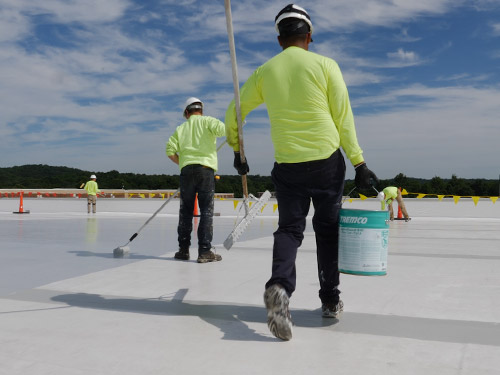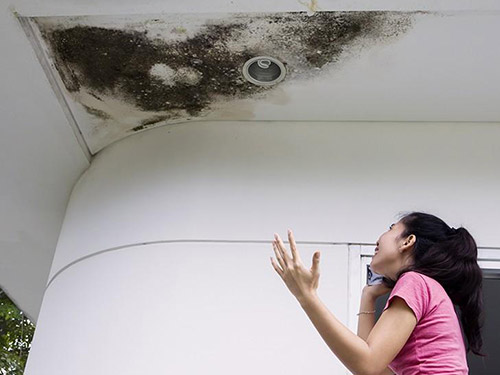According to Chubb Insurance, an estimated 15% of insurance claims in commercial buildings are caused by water intrusion, with roofs being the most common entry point. When water damage strikes a commercial building, the cost of repairs will be substantial, depending on the specific items requiring restoration.
When it leaks, it pours – not just water but also money! Imagine the business downtime, loss of merchandise and equipment, loss of insurance premium, damage to the flooring, ceiling, or drywall. Here, we share with you some of the common causes for waterproofing failures:
1. Flat roofs in commercial buildings

A flat roof is more common for large commercial buildings due to its ability to cover expansive areas more efficiently than pitched roofs. However, the downside of flat roofs is that it can collect excessive rain that leads to leaks, especially in multilevel buildings where the cause of waterproofing failure often comes from the higher floors. Top-floor levels can experience waterproofing problems from rainwater puddles forming on the roof. Additionally, poor workmanship on higher levels, such as defective plumbing, can also lead to waterproofing failure.
2. Incorrect waterproofing installation methodology
If the waterproof membrane is not sticking, it is highly likely due to debonding caused by several factors, including application of the membrane to an uneven surface or to a wet surface. Debonding can also happen when the waterproof membrane is applied to a contaminated surface, or not using enough primer on the surface prior to installation. Poor workmanship also includes using the wrong product specifications and insufficient substrate preparation before applying the waterproofing membrane.
3. Lack of maintenance
On-going maintenance in the form of checks and remedial waterproofing enables you to catch problems early and avoid significant issues like concrete cancer. Even tiny leaks and cracks should be dealt with right away as water damage can escalate quicker than expected, leading to major problems. Maintaining existing seals on your windows, doors, and wall systems is also recommended. Checking balconies, roofs, windows, cracks, and leaks as soon as you become aware of them and taking a proactive approach to maintenance minimises the risk that it develops into a major problem.
Membrane roofs are the most widely used roofing system because of their long lifespan, with membranes lasting for decades, offering an almost permanent waterproofing solution. They are also cost effective, typically being less expensive than other roofing systems such as metal roofs or tiles.
Why Choose TREMguard LLM
1. The TREMguard LLM is more than just a waterproofing sheet that protects against water penetration. Its white reflective surface reflects sunlight and UV rays away from the building, significantly reduces heat absorption.
2. Less heat entering the building reduces the need for air conditioning. This cuts down energy costs and lowers the overall carbon footprint of the building. This feature also enables Tremguard LLM to be certified by SGBC as a 4-tick product, achieving their ‘leader’ standards.

3. The smooth surface of TREMguard LLM waterproof membrane prevents dirt from accumulating. It is also easy to clean. All that's needed for routine inspections and small repairs is a quick visual check to make sure the membrane is still intact. If any minor problems are found, a simple patching can quickly fix them.
4. TREMGuard LLM roofing systems can last over 10 years, with the possibility of extending up to 25 years if properly installed by trained professionals. Thanks to its Thermoplastic Polyolefin (TPO) material, it is engineered to endure harsh weather conditions. They are resistant to cracks, splits, tears and are less affected by UV radiation, preventing rapid aging.

In 2024, we undertook a project at Impiana @ East Ledang Condominium in Johor, where we applied TREMguard LLM waterproof membrane covering an expansive area of more than 5,200 m². Read more about the case study here.
The importance of waterproofing should not be underestimated. It requires a dedicated team with specialised skillsets and experience to deliver the best application onto the roof surfaces. If not done properly, it can cause other issues resulting in water seepage and structural damage.
At TremcoCPG, we worked with a team of experienced applicators who are ready to support you with your waterproofing projects.


 Waterproofing and Roofing
Popular Types of Commercial Roofs and Waterproofing Systems
Waterproofing and Roofing
Popular Types of Commercial Roofs and Waterproofing Systems
 Waterproofing and Roofing
Sheet vs Fluid Applied Waterproofing
Waterproofing and Roofing
Sheet vs Fluid Applied Waterproofing
 Waterproofing and Roofing
Common Problems Associated with Poor Waterproofing
Waterproofing and Roofing
Common Problems Associated with Poor Waterproofing
